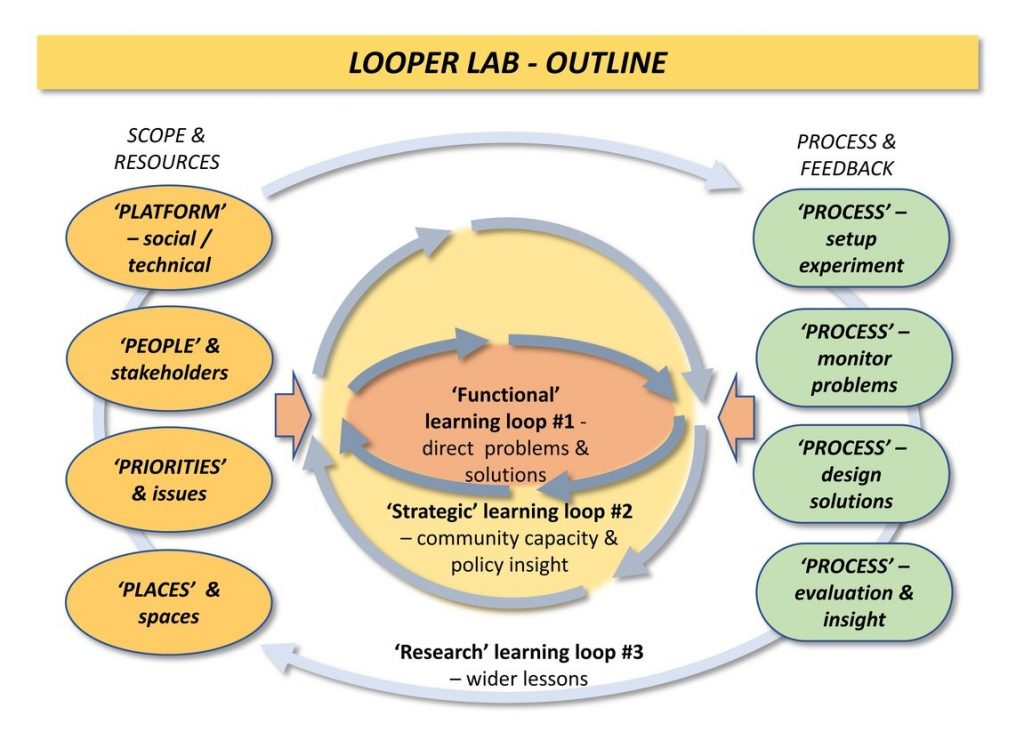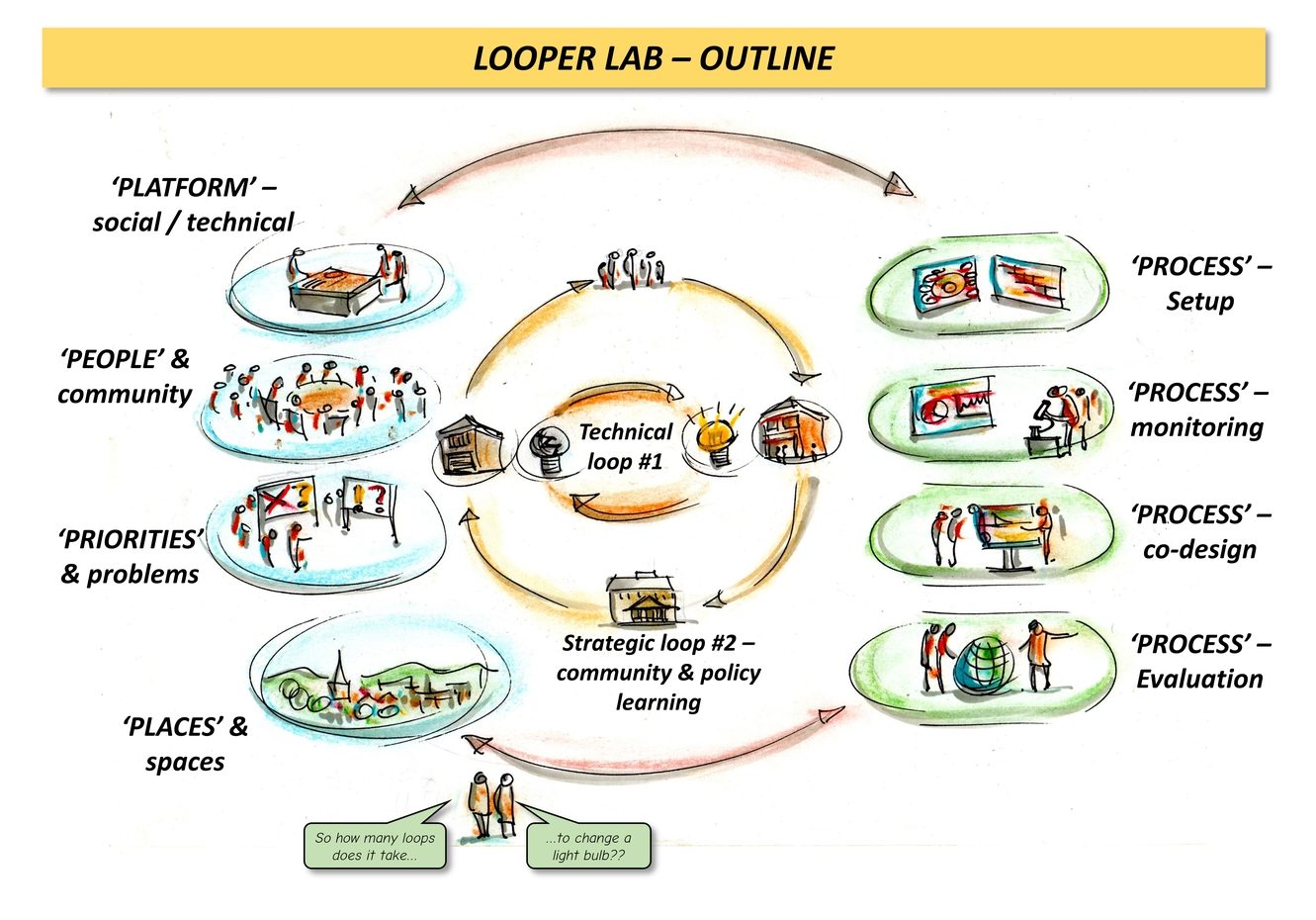Looper: ‘Learning Loops in the Public Realm’
The Looper project is setting up a Living Lab in 3 cities (Brussels, Manchester, Verona).
Each city is the site of a ‘Urban Living Lab for Learning Loops in the built environment’: this is called from now on, a ‘Looper Living Lab’. These are similar to other Urban Living Labs, such as those on energy or smart technology, but here there is a particular focus on the Learning Loops, that enable solutions to be tested and scaled up.
- A Looper Living Lab is a new model for experimental design and innovation at the urban and community level. It can address practical problems such as air quality, road safety, noise, crime or greenspace.
- A Learning Loop is the process of turning problems into solutions. The Loop is a cycle which transforms information into knowledge: knowledge into learning: learning into action: and action into feedback.
- Each of these works well in the local Built Environment : where community development and social enterprise can best show their potential, to help create cities which are more sustainable, prosperous and liveable.
Funding: JPI Urban Europe | Timescale: 2017 – 2020 | More information: http://looperproject.eu/ and http://www.jpi-urbaneurope.eu/project/looper
What are the components of a Looper Lab?
The Looper Lab includes five main‘P’ components:
Here you can create the content that will be used within the module.

- Place: we need to define the place (a local landmark, neighbourhood, landscape, or other area), where the lab is to be based.
- People; we need to gather the people to be involved (networks, organizations, groups or communities): and find ways to mobilize their energy and commitment.
- Priorities: we work with the people in the place, to explore their priorities (problems, issues, challenges, risks, opportunities, etc): both negative and positive.
- Platform: we arrange a system for the exchange of information, learning, debate, analysis and insight. Such a platform is now standard with digital technology: even more important is a human platform, a set of exchanges and interactions which host all the above.
- Process: we run an experimental process, which includes four main stages: experimental design and setup: monitoring the problems: co-design of solutions: and the evaluation and insight which come from the whole experiment.
The ‘experiment’ in this case is not only the solution to a particular problem: the experiment is about how people and communities and organizations ‘learn’. There are different levels of learning:
- Functional or ‘single loop’ learning is about how to solve specific problems with technical solutions:
- Strategic or ‘double loop’ learning is about wider and deeper problems, where the community can gain empowerment, and policy-makers can gain insight through learning.
- Research or ‘multi-loop’ learning is about the Lab as a whole, how the loops work, and how they can improve and transfer and scale up.
Typical applications and ‘use-cases’
Looper is working with a range of ‘use-cases’, i.e. common examples of practical problems and responses in urban communities. Each one has a different set of issues, challenges, political pressures etc. Each one has some combination of single loops for technical problems, and double loops for social / political problems. In the report, we use the Looper Lab template to analyse the components of each.
- Air quality: such problems need technical measurements which involve citizens (hand-held monitors etc), with technical mapping and visualization: as for responses, there are some local actions (planting trees, sealing of buildings), but to make real progress requires city-wide policies for industry and transport. In this case, empowering the community with information to press their case, is perhaps the most practical way forward.
- Road safety & parking: this is a political issue as to why some locations get road safety features & others don’t: so the community can gather data and analysis, and then explore possible local responses or how to put pressure on policy. Parking problems are from outside users, with issues of gentrification etc: also from internal competition for road space, which calls for social mediation.
- Noise pollution: this is a local issue, which calls for social collaboration between neighbours or different parts of the community. It is also an issue external to the community, with problems from roads, industry, sports or leisure: this calls for physical solutions (barriers, traffic calming etc which can be expensive), and also policy solutions.
- Crime and security: this involves at least 4 kinds of problem and response: perceived insecurity, harassment etc: anti-social behaviour calls for social mediation and/or enforcement: property & personal crime needs physical action and/or law enforcement: Organized crime / terrorism needs higher-level intelligence & enforcement (outside the Looper Lab project scope)
- Greenspace: this shows problems of anti-social behaviour, conflict between users, or local pollution. It also brings many creative opportunities, for nature conservation, tree planning, education, health, local food, events and festivals. For community design of the built environment greenspace is a good place to start.
What will be the results?
The Looper Lab in each city will make direct contributions to solving practical problems, including: air quality, noise, traffic safety, security and urban greenspace (‘single-loop learning’.
It will also help with local empowerment by community learning: and help with local governance capacity, by policy learning (‘double-loop learning’).
It will also help to advance the state of the art, with knowledge transfer and scaling up to other cities. It will do mapping and analysis of the learning loops at all levels, with new insights on barriers and opportunities (‘multi-loop learning’).
Overall this will contribute to ‘urban innovation’, both for practical problems, for communities and governance, and for analysts and researchers.

What is the synergistic dimension?
Synergistics also provides a framework with three levels, each representing a different mode of system organization and collective intelligence. These work in parallel with the three levels of learning loops:
- Mode-I – linear thinking / learning for functional systems
- Mode-II – evolutionary thinking / learning for adaptive / innovative systems
- Mode-III – co-evolutionary thinking / learning for reflexive / deliberative systems
This scheme can be usefully applied to the thinking / learning of both communities and policy / governance systems.
- Mode-I type problems can be solved with efficient management and decision-making systems: but the effect can be to increase the dependency of communities, and the bureaucracy of policy / governance systems.
- Mode-II type problems and responses are often fuzzy, embedded, controversial (e.g. crime hotspots). For communities, evolutionary thinking / learning can lead to social innovation, but also towards division and myopia. For policy and governance, evolutionary thinking / learning can lead to greater efficiency but also to competitive, exclusive, hierarchical actions.
- Mode-III type problems and responses call up the overall ’collective urban intelligence’. For commmunities, this can be tracked in ’wider’ networks and exchanges, and ’deeper’ forms of value. For policy and governance, such collective intelligence can be tracked with ’wider’ forms of transparency and inclusion, and ’deeper’ forms of valuation and evaluation.
